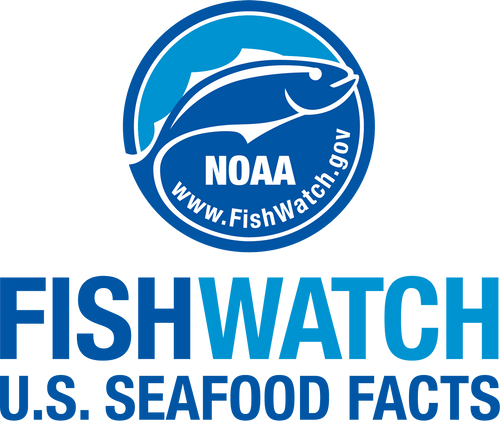 Atlantic skipjack tuna. Credit: NOAA Fisheries
Atlantic skipjack tuna. Credit: NOAA Fisheries
Atlantic skipjack tuna. Credit: NOAA Fisheries
About the Species
 Atlantic skipjack tuna. Credit: NOAA Fisheries
Atlantic skipjack tuna. Credit: NOAA Fisheries
Atlantic skipjack tuna. Credit: NOAA Fisheries
U.S. wild-caught Atlantic skipjack tuna is a smart seafood choice because it is sustainably managed and responsibly harvested under U.S. regulations.

Population
The stock is not overfished.

Fishing Rate
Not subject to overfishing.

Habitat Impact
Fishing gear used to harvest skipjack tuna has no impact on habitat because it does not contact the ocean floor.

Bycatch
Bycatch is minimal because rod-and-reel gear and handlines are very selective.
Population Status
- According to the 2022 stock assessment, Atlantic skipjack tuna is not overfished and not subject to overfishing. Summary stock assessment information can be found on Stock SMART.
- The International Commission for the Conservation of Atlantic Tunas (ICCAT) assesses the abundance of Atlantic skipjack tuna and evaluates the sustainability of current and proposed harvest practices. They use the scientific information from these assessments to make management recommendations.
- It’s difficult to assess the abundance of skipjack tuna due to its unique biological and fishery characteristics. Various assessment methods are used for skipjack tuna to overcome these difficulties, and several fishery indicators are analyzed for evidence of changes in the state of the stock over time.
Appearance
- Skipjack tuna do not have scales except on the corselet (a band of large, thick scales behind the head) and the faint lateral line running lengthwise down each side of the fish.
- Their back is dark purplish blue, and their lower sides and belly are silvery with four to six conspicuous longitudinal dark bands, which may look like continuous lines of dark blotches.
Biology
- Like other tropical tunas, skipjack tuna grow fast, up to over 3 feet and 40 pounds, and have a relatively short life span, around 7 years.
- In the eastern Atlantic, skipjack are able to reproduce when they’re 1 year old. They spawn throughout the year in tropical waters and seasonally (spring to early fall) in subtropical areas.
- Depending on their size, females can produce between 100,000 and 2 million eggs per year.
- Skipjack spawn more than once a season, as often as once per day.
- Once fertilized, the eggs hatch in about 1 day (depending on the temperature).
- Skipjack tuna are opportunistic feeders, preying on a variety of fish (e.g., herrings), crustaceans, cephalopods, mollusks, and sometimes other skipjack tunas.
- Large pelagic fishes such as billfish, sharks, and other large tunas prey on skipjack tuna.
Where They Live
Range
- Skipjack tuna are found in tropical, subtropical, and warm temperate waters of all oceans. In the western Atlantic, skipjack is found from Massachusetts to Brazil, including in the Gulf of Mexico and the Caribbean.
Habitat
- Skipjack tuna are a pelagic species. They mostly live in the open ocean, but they may spend part of their life in nearshore waters.
- They can be found in surface waters and to depths of 850 feet during the day and generally stay near the surface at night.
- Skipjack tuna is a highly migratory species, swimming long distances to feed and reproduce.
- They swim in schools, especially around floating objects or hydrographic features such as convergence zones and boundaries between cold and warm water masses. They also school around upwelling areas, where dense, cooler, and usually nutrient-rich water is pushed toward the ocean surface, replacing the warmer, usually nutrient-depleted surface water.
Fishery Management
- NOAA Fisheries and the Atlantic Highly Migratory Species Division manage the Atlantic skipjack tuna fishery in the United States.
- Managed under the Consolidated Atlantic Highly Migratory Species Fishery Management Plan:
- Commercial fishermen must have a permit to harvest skipjack.
- Gear restrictions.
- Federal management for Atlantic tunas applies to state waters as well, except in Maine, Connecticut, and Mississippi. NOAA Fisheries periodically reviews these states’ regulations to make sure they’re consistent with federal regulations.
- Highly migratory species, such as skipjack tuna have complicated management that requires international cooperation.
- The United States participates in regional fisheries management organizations, such as the International Commission for the Conservation of Atlantic Tunas (ICCAT), to enhance tuna management worldwide. NOAA Fisheries sets regulations for the U.S. western Atlantic skipjack tuna fishery based on our science as well as conservation and management measures adopted by ICCAT.
- No specific ICCAT management measures currently apply to skipjack tuna.
- In 2013, ICCAT adopted a measure to expand reporting requirements for tropical tuna fisheries using fish aggregating devices (FADs). The measure will improve data collection and allow ICCAT scientists to better characterize the fishing effort associated with FAD fishing.
- In 2000, the United States established the Dolphin-Safe Tuna Tracking and Verification Program to monitor the domestic production and importation of all frozen and processed tuna products nationwide and to authenticate any associated dolphin-safe claim.
Harvest
- Commercial fishery:
- Skipjack tuna are caught by U.S. vessels in the western North Atlantic, but are only a minor component of total U.S. tuna landings and a very small percentage of the total international landings of western Atlantic skipjack tuna.
- In 2020, the United States contributed less than one percent of the total western Atlantic skipjack landings.
- In 2022, commercial landings of Atlantic skipjack tuna totaled 216 pounds and were valued at $440, according to the NOAA Fisheries commercial fishing landings database.
- Almost all of the U.S. commercial harvest of skipjack tuna comes from the Pacific. Much of it is exported to foreign markets.
- Gear types, habitat impacts, and bycatch:
- In the Atlantic, U.S. commercial fishermen mainly use handgear to harvest skipjack tuna.
- Handgear includes rod-and-reel and handline gear, which consists of a mainline that is retrieved by hand with no more than two hooks attached.
- Handgear is highly selective and does not contact the ocean floor.
- Recreational fishery:
- U.S. recreational fishermen account for more of the total catch of skipjack tuna in the western Atlantic than commercial fishermen.
- In 2022, recreational landings of skipjack tuna totaled approximately 87,000 pounds, according to the NOAA Fisheries recreational fishing landings database.
- Recreational fishermen must have a permit to fish for skipjack tuna.
- Recreational fishing for highly migratory species such as skipjack tuna provides significant economic benefits to coastal communities through individual angler expenditures, recreational charters, tournaments, and the shoreside businesses that support those activities.
Scientific Classification
- Skipjack tuna are found in tropical, subtropical, and warm temperate waters of all oceans. In the western Atlantic, skipjack is found from Massachusetts to Brazil, including in the Gulf of Mexico and the Caribbean.
- Skipjack tuna are a pelagic species. They mostly live in the open ocean, but they may spend part of their life in nearshore waters.
- They can be found in surface waters and to depths of 850 feet during the day and generally stay near the surface at night.
- Skipjack tuna is a highly migratory species, swimming long distances to feed and reproduce.
- They swim in schools, especially around floating objects or hydrographic features such as convergence zones and boundaries between cold and warm water masses. They also school around upwelling areas, where dense, cooler, and usually nutrient-rich water is pushed toward the ocean surface, replacing the warmer, usually nutrient-depleted surface water.
Fishery Management
- NOAA Fisheries and the Atlantic Highly Migratory Species Division manage the Atlantic skipjack tuna fishery in the United States.
- Managed under the Consolidated Atlantic Highly Migratory Species Fishery Management Plan:
- Commercial fishermen must have a permit to harvest skipjack.
- Gear restrictions.
- Federal management for Atlantic tunas applies to state waters as well, except in Maine, Connecticut, and Mississippi. NOAA Fisheries periodically reviews these states’ regulations to make sure they’re consistent with federal regulations.
- Highly migratory species, such as skipjack tuna have complicated management that requires international cooperation.
- The United States participates in regional fisheries management organizations, such as the International Commission for the Conservation of Atlantic Tunas (ICCAT), to enhance tuna management worldwide. NOAA Fisheries sets regulations for the U.S. western Atlantic skipjack tuna fishery based on our science as well as conservation and management measures adopted by ICCAT.
- No specific ICCAT management measures currently apply to skipjack tuna.
- In 2013, ICCAT adopted a measure to expand reporting requirements for tropical tuna fisheries using fish aggregating devices (FADs). The measure will improve data collection and allow ICCAT scientists to better characterize the fishing effort associated with FAD fishing.
- In 2000, the United States established the Dolphin-Safe Tuna Tracking and Verification Program to monitor the domestic production and importation of all frozen and processed tuna products nationwide and to authenticate any associated dolphin-safe claim.
Harvest
- Commercial fishery:
- Skipjack tuna are caught by U.S. vessels in the western North Atlantic, but are only a minor component of total U.S. tuna landings and a very small percentage of the total international landings of western Atlantic skipjack tuna.
- In 2020, the United States contributed less than one percent of the total western Atlantic skipjack landings.
- In 2022, commercial landings of Atlantic skipjack tuna totaled 216 pounds and were valued at $440, according to the NOAA Fisheries commercial fishing landings database.
- Almost all of the U.S. commercial harvest of skipjack tuna comes from the Pacific. Much of it is exported to foreign markets.
- Gear types, habitat impacts, and bycatch:
- In the Atlantic, U.S. commercial fishermen mainly use handgear to harvest skipjack tuna.
- Handgear includes rod-and-reel and handline gear, which consists of a mainline that is retrieved by hand with no more than two hooks attached.
- Handgear is highly selective and does not contact the ocean floor.
- Recreational fishery:
- U.S. recreational fishermen account for more of the total catch of skipjack tuna in the western Atlantic than commercial fishermen.
- In 2022, recreational landings of skipjack tuna totaled approximately 87,000 pounds, according to the NOAA Fisheries recreational fishing landings database.
- Recreational fishermen must have a permit to fish for skipjack tuna.
- Recreational fishing for highly migratory species such as skipjack tuna provides significant economic benefits to coastal communities through individual angler expenditures, recreational charters, tournaments, and the shoreside businesses that support those activities.
Scientific Classification
| Kingdom | Animalia | Phylum | Chordata | Class | Actinopterygii | Order | Scombriformes | Family | Scombridae | Genus | Katsuwonus | Species | pelamis |
|---|
Last updated by NOAA Fisheries on 09/06/2024
Featured News
 School of yellowfin tuna. Credit: Jeff Muir
School of yellowfin tuna. Credit: Jeff Muir

 Grilled tuna lemon with mayo. Credit: North Carolina Sea Grant/Vanda Lewis.
Grilled tuna lemon with mayo. Credit: North Carolina Sea Grant/Vanda Lewis.
Seafood Facts

Is Atlantic Skipjack Tuna Sustainable?
U.S. wild-caught Atlantic skipjack tuna is a smart seafood choice because it is sustainably managed and responsibly harvested under U.S. regulations.
Availability
Fresh in late summer through early fall, and frozen and canned year-round.
Source
U.S. wild-caught from New York to Florida.
Taste
Skipjack tuna has the most pronounced taste of all of the tropical tunas.
Texture
Firm and moist with large flakes.
Color
When raw, good-quality skipjack tuna meat is deep red. Smaller fish are lighter red. Cooked skipjack becomes light gray.
Health Benefits
Skipjack is an excellent source of low-fat protein.
Nutrition Facts
Servings: 1; Serving Weight: 100 g (raw); Calories: 103; Protein: 22.00 g; Total Fat: 1.01 g; Total Saturated Fatty Acids: 0.328 g; Carbohydrate: 0 g; Total Sugars: 0 g; Total Dietary Fiber: 0 g; Cholesterol: 47 mg; Selenium: 36.5 mcg; Sodium: 37 mgMore Information
Last updated by NOAA Fisheries on 09/06/2024
Seafood News
 A signboard thanking patrons at Tuna Harbor Dockside Market in San Diego. Credit: Tuna Harbor Dockside Market.
A signboard thanking patrons at Tuna Harbor Dockside Market in San Diego. Credit: Tuna Harbor Dockside Market.
 Credit: NOAA Fisheries/Brianna Shaughnessy
Credit: NOAA Fisheries/Brianna Shaughnessy
 An oyster reef with lush greenery in the background. Credit: Adobe Stock
An oyster reef with lush greenery in the background. Credit: Adobe Stock
Outreach & Education
A Guide to Tunas of the Western Atlantic Ocean
Waterproof booklet to help commercial, for-hire, and recreational fishermen and fish dealers/buyers…
Caribbean Saltwater Recreational Fisheries Snapshot
Puerto Rico and the U.S. Virgin Islands saltwater recreational fisheries fact sheet highlighting…
Last updated by NOAA Fisheries on 09/06/2024





